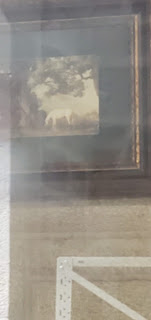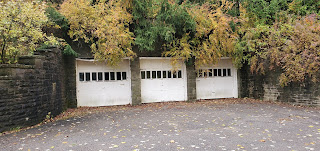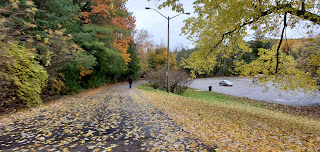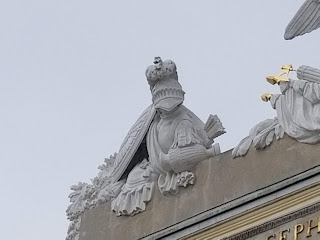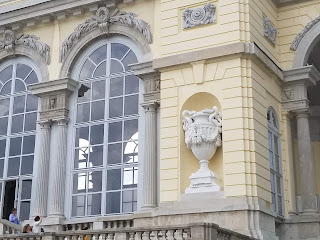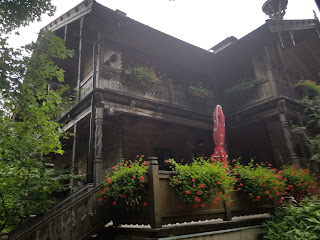
We observe few feature in the pictures.

Some of the windows are half of their length underground. Was this mud flooded building? If so when? Why would somebody build in Canada windows that are facing nothing when you have square km of land. and the building is in top of a hill.


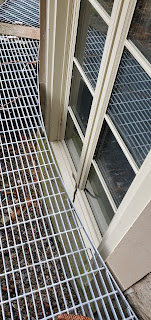
Large windows.
In top of the building interesting spherical devices in top of all towers.
 Cargo Cult or Wireless Electricity?
Cargo Cult or Wireless Electricity?





Similar round elements in top of exterior lighting devices outside the building.


We observe two type of constructions in the towers of these buildings one is round and another is octagonal as if they were built in different eras.



Are the stairs connecting the second floor of the building ?

Seneca Campus, Eaton Estate, Ferguson Farms, Crown Grants, Native ocupation
Pre 1800
The site is located at the south side of the Oak Ridges Moraine and includes a kettle lake, a residual depression resulting from the retreat of the last ice age.Signs of native occupation abound in the area and are more widely known in adjacent townships with a few (35) identified in King. This is not because there was little settlement but as there has been less archaeology work in King ( lack of development until recently) than elsewhere.An Archaeology Report was prepared for the site by the Toronto and Region Conservation Authority in October 2009. It was a stage one review of the area and it identifies the area around Lake Seneca as an area of high probability for archaeological remains of native occupation to exist.To the east of the site a system of rivers and streams was a significant canoe route between Lake Ontario and Lake Simcoe with a major portage required around what is called the Carrying Place.The native nations who occupied the area shifted in time and their history is complex. They Included the Huron and Neutral Nations. These later moved north. Other Algonquian speaking groups also used the area such as the Anishinaabe whomigrated eastward from the east coast, the Ojibway, Mississauga, and Cree.
In the late 18th Century after the American Revolution, the Crown began a series of land purchases and the establishment of specific land reserves for the local Natives.Such a reserve was created in this area for the Mississaugians in 1783, however this was altered by the Toronto Purchase.The area was included in the surveying of the Province in the County of York, and defined as King Township.
1800The lands were surveyed first in 1800 but this continued up to 1859. Lots were laid out on a line / concession grid. There are 12 concessions running west from Yonge Street of 1.25 miles and 7 side-roads running east west. Lots of c. 200 acres were created within this grid.18101820
Thomas Ferguson, part lots 4-5, Con 2. Born In Ayershire Scotland he became a weaver. He emigrated to Canada in 1820 to continue on as a weaver and farmer. In 1820 the property was totally bush land, he cleared the farm, made money as both weaver and farmer and died very comfortable.
1830
The Presbyterian Church began in 1834 as a shared use in a log building constructed as a school house
1840
Eversley Presbyterian church was constructed in 1843 on land purchased from Joseph Wells on Lot 9 Concession 3. This is still standing. The modest single storey church was constructed of stone rubble in a simple gothic style.Also in 1843 a new red brick building was constructed for the school, replacing the old log cabin. This school was further replaced by a buff brick school in 1883In 1847 Jon Ferguson owned lot 10 Concession 3 and on it built a saw mill. The dam for the sawmill created a mill pond out of the swampy depression south of the lake. The Mill pond extended north across the side road and connected to the lake. This depression can still be seen in the landscape.Thomas Ferguson second son of elder Thomas, bought last parts of lots 12, 13, and 14. con 3. Ferguson left the forest around the lake when he cleared for the farm.The lake was known as Ferguson Lake, later known as Lady Eaton Lake.All the kids went fishing here on May long weekend. He stocked the lake with carp and felt later he had made a mistake!
!850-1860
A store was opened in Eversley which included a post office in 1865. This was one of the first Buildings in the Hamlet
1870
In 1878 Job Wells and his brother James build a very successful cheese factory on the south west corner of lot 10.
1880
The now “old” red brick schoolhouse was replaced by a buff brick school which still survives as a part of a local private junior school / daycare.1910In 1912, Sir Henry Pellatt purchased over 1000 acres extending to and across Keele St. It also included a small kettle lake which he called Mary Lake after his wife. It is still known as Marie Lake.Pellatt installed a small railway for his guests convenience and this included a small station where the Horse Barn now stands and generally to service the estate. This was connected to the Grand Trunk Railway. With the encouragement of Sir. Henry Pellatt the Eaton family begin the acquisition of lands that will become the Eaton Estate. The initial purchase is the Ferguson Farm in 1919 and included lots 11 and 12, concession 3.. The assembly continues and the entire lake is included in the acquired lands. It had been called Ferguson Lake, but this was renamed Lake Johnda after their son (John David).
1920
The Eaton family completes the assembly of farms to create an estate of c. 696 acres. They use the old Ferguson House as a weekend retreat, and work on the development of the working farm and cattle for a dairy operation.
Eaton First Store: 1869
Timothy Eaton came to Canada from County Antrim (now in Northern Ireland) in 1854. He was part of the large wave of Irish migration during the 1840s and 1850s, and joined his eldest brother and sisters in Upper Canada. With his brother James, he entered into the dry goods and retail business, first in Kirkton, then St. Mary’s, Ontario. Eventually, Timothy and James began quarrelling over their business practices, and Timothy left for Toronto.In Toronto, Timothy and wife Margaret paid $6,500 for a dry goods retail operation. In December 1869, they opened a store that accepted cash only, at a fixed price, breaking with expectations of bargaining and credit sales. While not the first to do this in Canada, it was a bold decision for a new business. To attract customers, Eaton emphasised both quality and low prices, and also placed well-priced items in front of the store or just inside the doorway. He also developed a novel “Goods Satisfactory or Money Refunded” policy in 1870 — if the customer wasn’t happy, he would refund their money. Eaton also distinguished himself from competition by seeking to cut out wholesalers as much as possible. Most retailers relied on wholesalers who brought goods from manufacturers; Eaton went to the United Kingdom and Europe himself and bought directly from suppliers.
Timothy Eaton, died suddenly of pneumonia in 1907, and John Craig took over as company president. Eaton’s expanded under John Craig’s watch, with new mail order and distribution centres reaching Saskatoon and Regina, Saskatchewan and Moncton, New Brunswick between 1916 and 1920.
Eaton’s grew at a rapid pace during the 1920s as consumer demand grew. Timothy Eaton’s nephew, Robert Young (R.Y.) Eaton, took over the firm after John Craig’s death, from influenza, in 1922. The expansion included purchasing the Montréal retail firm Goodwin’s Limited. Through the decade, department stores were opened in Red Deer, Lethbridge, Medicine Hat, Edmonton and Calgary, Alberta; Saskatoon and Prince Albert, Saskatchewan; Hamilton and Port Arthur, Ontario; and Halifax, Nova Scotia. The company further grew after purchasing a small chain of retail stores, Canadian Department Stores, giving the company a presence throughout Ontario, including Chatham, Belleville, and Huntsville.
So basically Lady Eaton Build it since her husband died in 1922. Something is wrong here.
The Official Story according To Wikipedia
Eaton Hall is a large house in King City, Ontario, Canada, built in the Norman style for Lady Eaton in 1938-39 on a 700-acre (2.8 km²) parcel of land (partly the Ferguson farm). Lady Eaton and her husband, Sir John Craig Eaton acquired the land in 1920 and 1922 on recommendation from their friend Sir Henry Pellatt, who owned the nearby Mary Lake property. Lady Eaton moved into Eaton Hall three years after selling her city mansion, Ardwold. The house is adjacent to a body of water named Lake Jonda (a combination of the first three letters of her son John David Eaton's first and middle names), and nestled within the temperate forests of King Township. Upon completion, it contained 72 rooms. It became a beloved gathering place for the Eaton Family, owners of the Eaton's department stores based in Toronto.
Site plans and surveys for the property dating from 1921 to the 1930s all refer to its location being in Eversley.Design was started in 1932 by architects Peter L. Allward and George Roper Gouinlock, son of architect George Wallace Gouinlock (later by firm Allward and Gouinlock). Construction was completed in 1939 and was supervised by John W. Bowser of the Aurora Building Company.Its construction incorporated stones sourced from the nearby Humber River.
A history of the estate, Eaton Hall: Pride of King Township, was published by The History Press, an imprint of Dundurn Press in June 2015.
Flora Eaton was a member of the Toronto Hunt Club.In 1929, it split into the Eglinton Hunt Club and the Toronto and North York Hunt Club. Hunters of the latter held regular outings, meeting for breakfast at Eaton Hall, riding in the adjacent Pellatt Estate, then ending the day with an afternoon tea at Eaton Hall.
During WWII, the property was used as a convalescent hospital and rehabilitation centre for the Royal Canadian Navy from 1944 to 1946.
After Lady Eaton's death in 1970, the land was sold to Seneca College, which was then a provincially funded college of applied arts and technology. It established its King Campus operations on that land in 1971, using Eaton Hall as its administrative facility. In 1977, a new facility was built for the expanding college, and Eaton Hall became a Management Development Centre until 1991, at which time it was converted to a public hotel and conference centre.
Eaton’s, founded by a Northern Irish immigrant, was closely tied to the idea of Canada as part of the British world and empire. The firm celebrated the links between Eaton’s, the railroad, and Canadian industrial and economic development. For instance, advertisements cast the company’s expansion into Winnipeg as a major moment not just for the company, but also for Canadian western expansion. The company took pains to emphasize the links between Canadian and British identity and colonialism. Company stores marked coronations and royal visits to Canada with lavish decorations, Union Jacks and other icons of Britain; this was done for the visit of the future King Edward VII in 1901, the coronation of King George VI in 1937, as well as King George’s subsequent visit in 1939. During the First World War, John Craig’s efforts to provide and promote contributions to the war effort led to his knighting in 1915.
Many movies and television programs have been filmed at Eaton Hall, including Death Weekend, Mrs. Winterbourne, and the final scene of the award-winning film A History of Violence.
Sir John Craig Eaton is the original owner but didn't live long enough to see its completion. Lady Flora McCrae Eaton was his wife; she lived there. This establishment served to care for burn victims from World War II. One of their sons hanged himself on the third floor in a 'circular' room (the room is located to the left of the elevator). Their other son apparently drowned in the lake. Lady Flora supposedly walks the halls; some staff members have seen her. One staff member said, "...if you see her, say hi".
| Eaton's | |
| Private (1869–1998) Public (1998–1999) | |
| Industry | Retail (Department store) |
| Fate | Filed for bankruptcy; assets were purchased by Sears Canada in 1999. Several stores were re-opened by Sears under the eatons brand, but all were converted to Sears stores or shut down in 2002. |
| Founded | 1869 |
| Founder | Timothy Eaton |
| Defunct | 1999 as a company 2002 as a brand |
| Headquarters | Toronto, Ontario (with stores across Canada) |
Key people
| Timothy Eaton John Craig Eaton John David Eaton |
| Products | Everything from clothing to farming implements |
Number of employees
| 70,000 |
In 1869, Timothy Eaton sold his interest in a small dry-goods store in the market town of St. Marys, Ontario, and he bought a dry-goods and haberdashery business at 178 Yonge Street in the city of Toronto.
The first store was only 24 by 60 feet (7.3 m × 18.3 m), with two shop windows, and was located a fair distance from Toronto's then fashionable shopping district of King Street West. In its first year of operation, with Timothy Eaton responsible for buying the goods to stock the store, and a staff of four, expectations were low that a store with a no-credit and no-haggling policy would succeed.
The business prospered, and Eaton moved the store one block north in August 1883 into much larger premises at 190 Yonge Street. The new store boasted the biggest plate-glass windows in Toronto, the first electric lights in any Canadian store, three full floors of retail space featuring 35 departments, and a lightwell that ran the full-length of the store. The store's first telephone, with phone number 370, was installed in 1885. In 1886, the first elevator in a retail establishment in Toronto was installed in the Eaton store (although only customers going up were invited to use the elevator, thus requiring them to pass by the various store displays on their walk down).
Eaton maintained the lease on the empty store at 178 Yonge Street until its expiry in 1884 in order to delay the expansion plans of one of his competitors, Robert Simpson. Over time, the competition between the Simpson's and Eaton's department stores, facing each other across Queen Street West, became one of Toronto's great business rivalries. The pedestrian crosswalk on Queen Street West, just to the west of the intersection with Yonge Street, was for years one of the busiest in Canada, as thousands of shoppers a day comparison-shopped between Eaton's and Simpson's.
By 1896, Eaton's was billing itself as "Canada's Greatest Store". The store continued to expand in size, and new buildings were constructed to house the mail order division and the Eaton's factories. The number of people employed in Eaton's operations numbered 17,500 in 1911. In 1919, the Eaton's buildings in Toronto contained a floor space of over 60 acres (240,000 m2), and occupied several city blocks between Yonge Street and Bay Street, north of Queen Street West.
Links
https://www.torontoghosts.org/index.php/the-province-of-ontario/south-central/233-king-city-eaton-hall?showall=1
https://www.blogto.com/city/2016/08/that_time_toronto_demolished_the_heart_of_yonge_st/
https://www.theglobeandmail.com/news/national/eatons-department-store-heir-thor-eaton-loved-horses-and-rock-music/article34768703/
https://en.wikipedia.org/wiki/Eaton%27s
https://www.thecanadianencyclopedia.ca/en/article/t-eaton-company-limited
https://www.senecacollege.ca/about/masterplan/pdf/Final_Heritage_Report_2012.pdf
The stone seems to be burned.




































